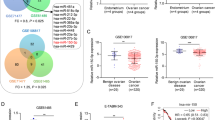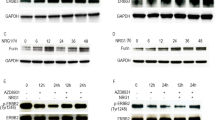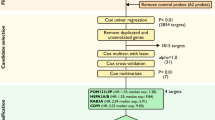Abstract
Metastasis and invasion occur in the majority of epithelial ovarian carcinoma at diagnosis. To delineate the molecular signature in ovarian cancer invasion, we established and characterized a human ovarian endometrioid carcinoma (EC) cell line OVTW59-P0 and its invasion-related sublines (P1–P4, in the order of increasing invasive activity). P4 showed faster migration and larger xenograft formation with metastasis than P0. By microarray analysis of different gene expression among P0–P4 sublines, one group of gene was found negatively correlated with cancer invasion. Among these genes, IGFBP-3 was identified as one of the most remarkably suppressed gene that showed lower gene expression in P4 than P0. Re-expression of IGFBP-3 in P4 effectively inhibited cell migration, invasion and metastasis, but did not affect cell proliferation. In 35 patients with EC tumors, low IGFBP-3 expression correlated clinically with higher tumor grade, advanced stage and poor survival. Our results provide evidence and indicate that IGFBP-3 plays an important role as an invasion-metastasis suppressor in ovarian EC.
This is a preview of subscription content, access via your institution
Access options
Subscribe to this journal
Receive 50 print issues and online access
$259.00 per year
only $5.18 per issue
Buy this article
- Purchase on Springer Link
- Instant access to full article PDF
Prices may be subject to local taxes which are calculated during checkout





Similar content being viewed by others
References
Al-Shahrour F, Diaz-Uriarte R, Dopazo J . (2004). FatiGO: a web tool for finding significant associations of gene ontology terms with groups of genes. Bioinformatics 20: 578–580.
Bell KA, Kurman RJ . (2000). A clinicopathologic analysis of atypical proliferative (borderline) tumors and well-differentiated endometrioid adenocarcinomas of the ovary. Am J Surg Pathol 24: 1465–1479.
Chu YW, Yang PC, Yang SC, Shyu YC, Hendrix MJ, Wu R et al. (1997). Selection of invasive and metastatic subpopulations from a human lung adenocarcinoma cell line. Am J Respir Cell Mol Biol 17: 353–360.
Firth SM, Baxter RC . (2002). Cellular actions of the insulin-like growth factor binding proteins. Endocr Rev 23: 824–854.
Goodman MT, Correa CN, Tung KH, Roffers SD, Wu XC, Young JL et al. (2003). Stage at diagnosis of ovarian cancer in the United States, 1992–1997. Cancer 97: 2648–2659.
Hendrix MJ, Seftor EA, Seftor RE, Fidler IJ . (1987). A simple quantitative assay for studying the invasive potential of high and low human metastatic variants. Cancer Lett 38: 137–147.
Jiang X, Morland SJ, Hitchcock A, Thomas EJ, Campbell IG . (1998). Allelotyping of endometriosis with adjacent ovarian carcinoma reveals evidence of a common lineage. Cancer Res 58: 1707–1712.
Juan HF, Lin JY, Chang WH, Wu CY, Pan TL, Tseng MJ et al. (2002). Biomic study of human myeloid leukemia cells differentiation to macrophages using DNA array, proteomic, and bioinformatic analytical methods. Electrophoresis 23: 2490–2504.
Kang Y, Siegel PM, Shu W, Drobnjak M, Kakonen SM, Cordón-Cardo C et al. (2003). A multigenic program mediating breast cancer metastasis to bone. Cancer Cell 3: 537–549.
Katsaros D, Yu H, Levesque MA, Danese S, Genta F, Richiardi G et al. (2001). IGFBP-3 in epithelial ovarian carcinoma and its association with clinico-pathological features and patient survival. Eur J Cancer 37: 478–485.
LeRoith D, Roberts CT . (2003). The insulin-like growth factor system and cancer. Cancer Lett 195: 127–137.
Lin CT, Chan WY, Chen W, Huang HM, Wu HC, Hsu MM et al. (1993). Characterization of seven newly established nasopharyngeal carcinoma cell lines. Lab Invest 68: 716–727.
Lu L, Katsaros D, Wiley A, Rigault de la Longrais IA, Risch HA, Puopolo M et al. (2006). The relationship of insulin-like growth factor-II, insulin-like growth factor binding protein-3, and estrogen receptor-á expression to disease progression in epithelial ovarian cancer. Clin Cancer Res 12: 1208–1214.
McCluggage WG . (2002). Recent advances in immunohistochemistry in gynaecological pathology. Histopathology 40: 309–326.
McGuire WP, Hoskins WJ, Brady MF, Kucera PR, Partridge EE, Look KY et al. (1996). Cyclophosphamide and cisplatin versus paclitaxel and cisplatin: a phase III randomized trial in patients with suboptimal stage III/IV ovarian cancer (from the Gynecologic Oncology Group). Semin Oncol 23: 40–47.
Mishra S, Murphy LJ . (2004). The effects of insulin-like growth factor binding protein-3 (IGFBP-3) on T47D breast cancer cells enriched for IGFBP-3 binding sites. Mol Cell Biochem 267: 83–89.
Oh SH, Kim WY, Kim JH, Younes MN, El-Naggar AK, Myers JN et al. (2006a). Identification of insulin-like growth factor binding protein-3 as a farnesyl transferase inhibitor SCH66336-induced negative regulator of angiogenesis in head and neck squamous cell carcinoma. Clin Cancer Res 2: 653–661.
Oh SH, Lee OH, Schroeder CP, Oh YW, Ke S, Cha HJ et al. (2006b). Antimetastatic activity of insulin-like growth factor binding protein-3 in lung cancer is mediated by insulin-like growth factor-independent urokinase-type plasminogen activator inhibition. Mol Cancer Ther 5: 2685–2695.
Ohwada M, Suzuki M, Suzuki T, Hiratsuka M, Kawai T, Saito K et al. (2001). Problems with peritoneal cytology in second-look laparotomy performed in patients with epithelial ovarian carcinoma. Cancer 93: 376–380.
Sayer RA, Lancaster JM, Pittman J, Gray J, Whitaker R, Marks JR et al. (2005). High insulin-like growth factor-2 (IGF-2) gene expression is an independent predictor of poor survival for patients with advanced stage serous epithelial ovarian cancer. Gynecol Oncol 96: 355–361.
Silha JV, Sheppard PC, Mishra S, Gui Y, Schwartz J, Dodd JG et al. (2006). Insulin-like growth factor (IGF) binding protein-3 attenuates prostate tumor growth by IGF-dependent and IGF-independent mechanisms. Endocrinology 147: 2112–2121.
Simpson JL, Bischoff FZ . (2002). Heritability and molecular genetic studies of endometriosis. Ann N Y Acad Sci 955: 239–251.
Torng PL, Mao TL, Chan WY, Huang SC, Lin CT . (2004). Prognostic significance of stromal metalloproteinase-2 in ovarian adenocarcinoma and its relation to carcinoma progression. Gynecol Oncol 92: 559–567.
Valentinis B, Bhala A, DeAngelis T, Baserga R, Cohen P . (1995). The human insulin-like growth factor (IGF) binding protein-3 inhibits the growth of fibroblasts with a targeted disruption of the IGF-I receptor gene. Mol Endocrinol 9: 361–367.
Wiley A, Katsaros D, Fracchioli S, Yu H . (2006). Methylation of the insulin-like growth factor binding protein-3 gene and prognosis of epithelial ovarian cancer. Int J Gynecol Cancer 16: 210–218.
Acknowledgements
We thank Dr Tsui-Lien Mao from the Department of Pathology for pathological diagnosis, Miss Li-Shu Chang from the Department of Medical Genetics for karyotypic analysis and Dr Chee-Jen Chan from the Department of Medical Research for consultation in statistic analysis. We also thank Dr Wen-Hwa Lee from the University of California at Irvine for his helpful discussion. This work was supported partly by National Science Council (NSC94-2314-B-002-208), National Health Research Institutes (NHRI-EX94-9416B1, NHRI-EX95-9416B1) and National Taiwan University Hospital (NTUH92-S057).
Author information
Authors and Affiliations
Corresponding author
Additional information
Supplementary Information accompanies the paper on the Oncogene website (http://www.nature.com/onc).
Rights and permissions
About this article
Cite this article
Torng, PL., Lee, YC., Huang, CY. et al. Insulin-like growth factor binding protein-3 (IGFBP-3) acts as an invasion-metastasis suppressor in ovarian endometrioid carcinoma. Oncogene 27, 2137–2147 (2008). https://doi.org/10.1038/sj.onc.1210864
Received:
Revised:
Accepted:
Published:
Issue Date:
DOI: https://doi.org/10.1038/sj.onc.1210864
Keywords
This article is cited by
-
Diabetes and ovarian cancer: risk factors, molecular mechanisms and impact on prognosis
Endocrine (2023)
-
OSI-906 restores the sensitivity of ovarian clear cell carcinoma to cisplatin by targeting the IGF1R/AKT pathway
Medical Oncology (2022)
-
Insulin-like growth factor binding protein 3 promotes radiosensitivity of oral squamous cell carcinoma cells via positive feedback on NF-κB/IL-6/ROS signaling
Journal of Experimental & Clinical Cancer Research (2021)
-
Differential expression of hypoxia-inducible factors related to the invasiveness of epithelial ovarian cancer
Scientific Reports (2021)
-
Early urinary protein changes during tumor formation in a NuTu-19 tail vein injection rat model
Scientific Reports (2020)



